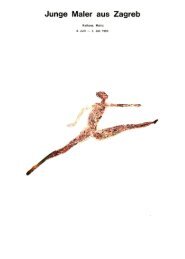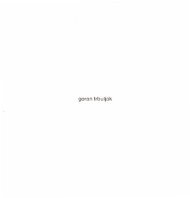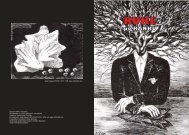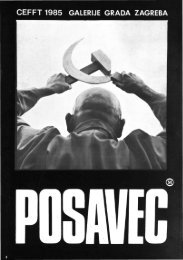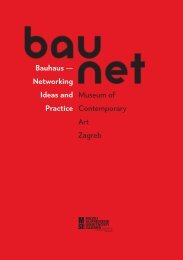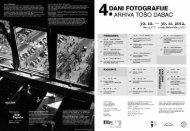Chen Zhen - Muzej suvremene umjetnosti Zagreb
Chen Zhen - Muzej suvremene umjetnosti Zagreb
Chen Zhen - Muzej suvremene umjetnosti Zagreb
You also want an ePaper? Increase the reach of your titles
YUMPU automatically turns print PDFs into web optimized ePapers that Google loves.
ŽelimirKoščevićSix roots To <strong>Chen</strong> <strong>Zhen</strong>, the world is not an object. ltis not even a correlate in the subjectivecontemplative process so typical of the Western way of thinking. Seen by <strong>Chen</strong>, theworld is above all a state of energy ruled by the flow of polar forces, forces which, ifwe may be permitted, we will name yin and yang. The nature of those endlessly drclingforces is almost unfathomable to the "practical mind", but it also poses a challengeto all who sense that there is something more hidden behind the power of cognisance,a power of feeling and a power of yeaming. And although the art of the Westkept indicating that "something", it was somehow never really believed. The ensuingresult was that the problem, and the accompanying challenge were, so to speak. aestheticized,in other words, marginalized and eased out of the sphere of serious philosophiethought. The early Greeks, those before Socrates, did sense that certain something,but then they "developed", which is why the essence and the nature - havingundergone a string of modifications, schools of thought and discip1ines - reached usdown the centuries in, to put it mildly, a rather confusing version.Apart from the fact that it certainly happened in the last, or rather, in the aoth century,it is not all that important exactly when the serious changes, which challengedthe Western mind-set and view of the world, did occur. The point at issue was notonly an in-depth examination of one's own conscience, but also a widening of cognitivehorizons and enrichment of the European sensory experience with those of others:African, Iranian, Latin-American, Aboriginal, Hinduist, Taoist, Zenist, and soforth. The post-modernistic, i.e. European, concept of the end of history is a logicalconsequence of this horizontal expansion and vertical penetration which, at thispoint in time, are of global proportions. lt can therefore, following a serious and criticalexamination of both the attainments and failures of the profusion of post-modernistictheories, and given the correct understanding, be quite genuinely regarded asbeing akin to the roots of <strong>Chen</strong> <strong>Zhen</strong>'s creative inspiration.When talking about the concept behind this one-man exhibition by <strong>Chen</strong> <strong>Zhen</strong> in theMuseum of Contemporary Art in <strong>Zagreb</strong>, which now has its beginning and its end, 1have in a rather ignorant manner typical of my general education assumed that if asix-cycle installation begins with a poetic-eome-plastic metaphor of birth, then -Iogically- its ending must inevitably be death. <strong>Chen</strong> wasted no time in setting my erroneousthinking straight. "No," - he said - "not death, but an ending." If one bears inmind that "the beginning" itself has not been strictly defined, what we get betweenthat which could be called 'the beginning', and that which could be called "the ending",is the alluring and provocative interspace, and being between is the fundamentalspiritual and, to a degree, a physical determinant of that void."The West excets in pravtdtnq definitions for all and everything. Ifind it quite difficultto classify my work within such logic. My interest lies more with the elements I use tocreate than it does with the form of assemblage, collage or an installation. Icomposemy "Chinese prescripttons" on the basis ofa very meticulous selection ojthoseelementswhich I incorporate into a composition." J Possessing the knowledge and experience ofan ivoryengraver, acquired at the School of Applied Arts in Shanghai, and being able14



